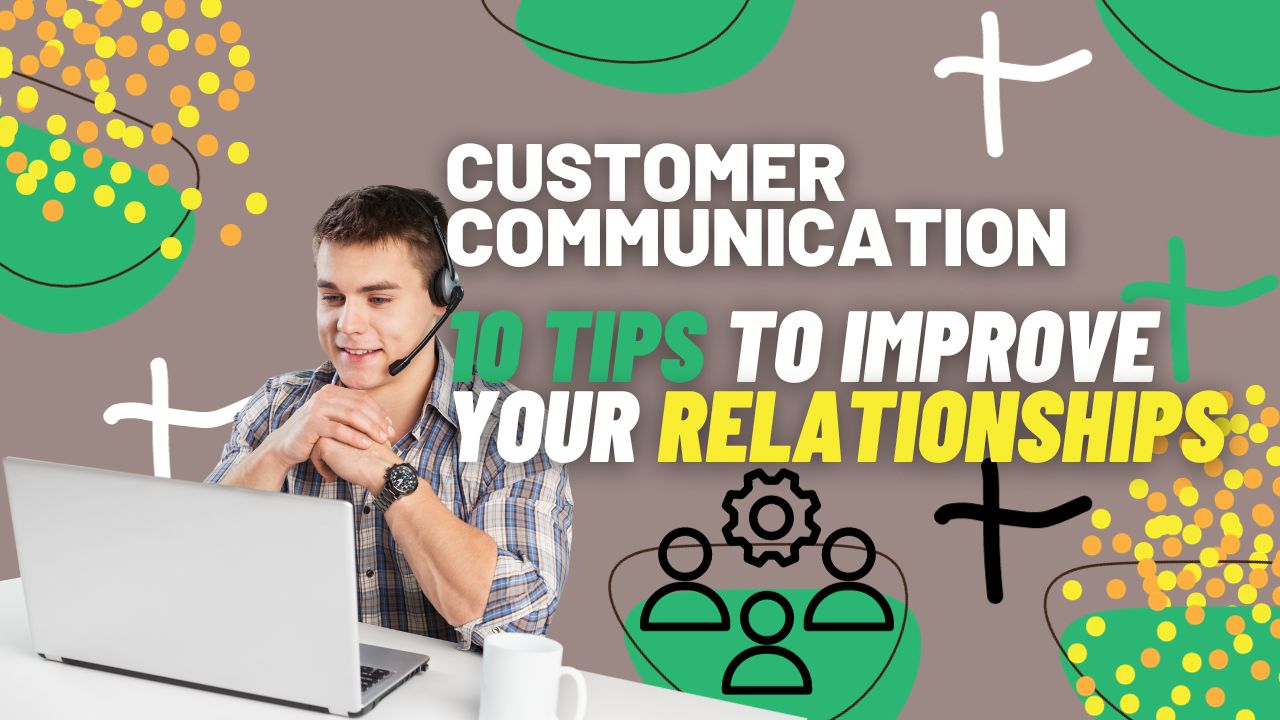
Some individuals choose a company based solely on the quality of its products or services. However, a company must also provide excellent customer service and communication in order to establish a strong brand and foster a lasting relationship.
In fact, over 75% of customers will continue doing business with a company even after it has made a mistake if the communication is excellent. They will also recommend it to others, enabling the company to stand out from the competition and effortlessly attract more customers.
In this article, we will share ten tips on customer communication, including tools and examples from successful businesses and professionals. You will also gain an understanding of essential customer communication skills and the benefits they can bring to your company.
What are the most important customer communication skills?
In this section, we will delve into the essential skills required for effective customer communication. These skills are a combination of emotional and interpersonal aptitudes that enable clear and meaningful conversations with customers.
- Self-awareness
Effective customer communication begins with self-awareness. You may have trained yourself to observe the behaviors of your customers, but it’s equally important to observe what’s happening within yourself. Enhance your self-awareness by studying your strengths, weaknesses, your products or services, and areas for improvement within your personality and business. This skill also enables you to acknowledge your mistakes and demonstrate how you intend to correct them based on your brand’s values, fostering trust.
- Empathy
Empathy involves understanding your customers’ perspectives and responding accordingly. Refine this skill by considering yourself a legitimate member of your customer’s team to become more engaged in their work and assess each situation from their point of view.
- Active Listening
Active listening entails giving your customers the necessary attention and providing appropriate feedback, such as nodding and asking relevant questions.
- Flexibility
It’s essential to adapt to various customers, including their personalities, schedules, and preferred communication methods. Show flexibility to make your customers comfortable and strengthen the relationship. For instance, some customers may treat you like a friend by sharing personal stories, while others prefer to stick to business. Another example is in performance assessments: some customers like a comprehensive analysis, while others want you to focus on specific parameters.
- Patience
Patience can reward your business by increasing customer satisfaction, improving sales, and garnering positive recognition. It’s also a valuable asset in customer relationship management. It helps you understand what a customer wants and formulate the right solutions. For example, if your customer asks numerous questions about a proposal, check if it’s well-structured and comprehensible. If not, revise the proposal and use bold or highlighted text to emphasize key points.
- Transparency
Transparency is the cornerstone of an honest, open, and enduring relationship. Inform customers of what they need to know, whether it’s good or bad news. You can be forthright about prices and their changes, announce policy adjustments, and promptly disclose your mistakes. When discussing your errors, don’t forget to explain how you intend to resolve them.
Top 10 Best Practices for Communicating Effectively with Customers
Now that we’ve gained an understanding of the important customer communication skills, let’s put them into practice by following the advice below.
1. Establish an emotional connection with the customer
- Build an Emotional Connection with the Customer: Communicating with customers on a personal level will help you understand them, fostering brand loyalty. Customers who have an emotional connection with a brand tend to have a higher lifetime value and are likely to recommend it to their friends.The first step is to get to know your customer on a personal level. Gather their demographic data, preferences, issues, needs, and desires through an online survey or by creating a customer profile.For example, graphic designer Abi Connick always asks her clients to specify their brand and objectives on her personalized portal. This helps establish clear expectations and avoids back-and-forth email exchanges with scattered information.
Also, demonstrate empathy towards your customers and show that you care about their challenges. Take inspiration from Zappos. This company has established a customer service hotline that people can call for any reason, in response to the rise in loneliness and anxiety related to the COVID-19 pandemic.
Another excellent idea is to showcase the inner workings of your team to increase transparency and build trust. For example, a web development agency can publish a summary of its web developers’ CVs on its website or share its daily activities on social media.
2. Maintain communication adapted to the context
Maintaining context-specific communication with customers helps prevent confusion and fosters mutual respect. To achieve this, consider the following advice:
- Use Precise Language: Avoid words like “almost” or “maybe,” as they can be confusing, especially when discussing project progress and deadlines. Provide accurate information so that customers know when and what to expect.
- Provide a Brief Explanation: Occasionally, obstacles leading to project delays, such as a poor internet connection or power outages, can occur. In such cases, inform the customer in advance that you won’t meet the deadline and suggest an alternative date. This helps customers adjust their schedules and maintains their trust in your business.
- Discuss What Matters: Organize discussions on critical topics and avoid overloading customers with too much information in a single conversation, which can be overwhelming.
- Turn Thoughts into Visuals: Use visual elements to convey your ideas effectively, such as screenshots, sketches, mind maps, or mock-ups. Canva is a useful tool for this practice, offering various visual templates and allowing users to provide feedback. Web development companies can use tools like Figma to share files and prototypes.
By implementing these communication practices, you can ensure that your interactions with customers are clear, respectful, and relevant to the situation at hand.
3. Practice Active Listening
Active listening is crucial for understanding a customer’s needs, especially during the initial request. Gathering more information in the beginning reduces the risk of errors and changes in the later stages of the process.
Active listening starts by eliminating distractions, such as turning off your phone and paying close attention to customers. Here are some tips to put active listening into practice:
- Remember What Customers Say: Focus on the key points and remember their names. If you plan to take notes, have your tools ready before the conversation begins.
- Ask Questions: Keep the conversation flowing and show your interest by asking open-ended questions. For example, “Could you tell me more about that?” or “What did you think of the proposal?”
- Reflect Customer Points: After the customer has finished speaking, paraphrase and summarize the conversation. For instance, you can say, “In other words, what you’re saying is that you’re frustrated about…” to ensure you’ve understood the message correctly.
Additionally, pay attention to non-verbal cues, such as facial expressions and gestures, as they make up more than 60% of communication. For example, a customer rolling their eyes or checking their watch may indicate boredom or disinterest.
During active listening, your non-verbal signals are equally important. This includes nodding at key points, maintaining eye contact, and avoiding crossing your arms.
4. Pay attention to the tone of the conversation.
Appropriate tone, grammar, and language structure reflect quality communication with customers, attention to detail, and professionalism. Follow these practices when communicating with customers in writing:
- Choose the Most Appropriate Greeting Style: To maintain professionalism in your message, avoid being overly friendly and chatty, especially in initial conversations. Feel free to adapt your style to match your customer’s in subsequent messages.
- Use a Positive Sentence Structure: Negative sentence structures can sometimes be confusing, such as “Don’t like the design?”.
- Grammarly is an excellent proofreading tool to check the tone of your text. It can review every detail, from grammar to readability, and detect how your text might be perceived by customers.
Tone is also crucial. It’s one of the essential elements of non-verbal communication, along with voice volume, intonation, and speed. These non-verbal cues often reveal a lot about a person. For example, a loud tone of voice can indicate enthusiasm and approval, while a hesitant tone may imply disinterest or disapproval.
5. Utilize Customer Communication Tools
In today’s remote work environment, the need for reliable customer communication tools becomes increasingly evident. Here are three customer communication software options that can help you manage your projects both online and offline without stress:
- Project Management Tool – ProofHub: ProofHub is an all-in-one project management software that allows you to centralize customer-related information and efficiently manage tasks through schedules, boards, and calendars. This customer management software enables both parties to upload files and communicate via chat and comments, enhancing transparency within your organization and externally.Price: Starting at $45/month for annual billing
- Virtual Meeting Software – Zoom: Zoom allows businesses and their clients to meet virtually via video or audio. It offers recording capabilities for attendees who can’t attend a meeting and engagement features like whiteboards and polls to enhance customer communication.Price: Freemium with paid plans starting at $149.9/year per user.
- Online Form Builder – Typeform: Surveys enable businesses to gather valuable insights from customers. With Typeform, you can create questionnaires to understand customer needs and personalities or collect feedback once a project is completed. This customer communication tool offers various templates, so you don’t have to start from scratch when structuring your forms.Price: Starting at $25/month.
As customers appreciate effective communication with a business, we recommend using tools well-known in your industry.
6. Train Employees in Communication
For business owners with customer support or customer service teams, improving their communication skills should be a priority, as they are typically the first to interact with customers. Here are some training ideas for effective customer service:
- Role-Playing: Customer service agents need experience in handling different clients, situations, and questions. Create role-play scenarios within your internal team, such as dealing with upset customers or potential clients with many questions.
- Product Knowledge Training: Organize demonstration sessions where your team presents products to each other and provide constructive feedback. Also, create a knowledge base – a resource containing articles from the help center, user guides, and frequently asked questions with answers about your product or service.
- Teach the LAST Method: LAST stands for Listen, Acknowledge, Solve, and Thank. This method encourages the team to pause, listen, apologize to upset customers, and then find a solution.
- Mentorship Program: Promote collaboration and knowledge sharing between newcomers and senior team members. This helps new employees feel more comfortable in their roles and build valuable relationships with colleagues.
- Team Meetings: Customer management can be stressful, so organize team meetings where colleagues can bond and relax.
To ensure consistent quality, conduct regular training sessions, especially during times of crisis or product and company updates.
If you’re still in the process of hiring customer service agents, make sure that candidates exhibit signs of emotional intelligence, such as empathy and active listening, to better connect with your customers.
7. Respect the Customer’s Time
The speed of your response significantly impacts the customer’s experience, especially in the early stages. If you take too long to respond, the customer may think you’re too busy to take on a project or give them special attention.
However, being consistently responsive can be challenging for solo entrepreneurs who do the work themselves. Set up automated response messages to inform your customers of your working hours and let them know you will contact them as soon as possible.
Decide on communication schedules with customers, especially when dealing with international clients. In general, the frequency depends on the project’s duration. For instance, a one-week project will require more communication than a project spanning several months.
Consider using an online collaborative tool like ProofHub or Asana so that customers can track project progress in real-time without the need for frequent meetings.
8. Avoid Making Assumptions
The next piece of advice for improved customer communication is to refrain from making hasty assumptions. Such assumptions can lead to misunderstandings and erroneous outcomes, as they are born from human biases.
Some common erroneous assumptions in customer communication include:
- Assuming that all customers are familiar with all our products or services.
- Assuming that all customers understand or use the same terminology and jargon.
- Assuming that the same strategies and treatments work for all customers.
- Assuming that cultural differences have no significant impact on customer behaviors and beliefs.
Underlying assumptions may stem from business leaders thinking too quickly, disregarding data and facts, and relying too much on their own experiences. Therefore, familiarize yourself with the people you are communicating with and reevaluate your beliefs about customers.
If you’re unsure, it’s better to be open and ask numerous questions rather than pass judgment. Make sure you are on the same page with customers regarding metrics, objectives, and jargon. It is also essential to encourage them to ask questions if they have doubts or don’t understand something.
9. Request and Provide Feedback
Customer feedback is an excellent way to gain insights into their expectations and rectify communication errors. It allows business leaders to see things from the customer’s perspective and determine their strengths and weaknesses.
When creating a feedback form, start with ratings or multiple-choice questions and delve deeper with open-ended questions. Seek feedback on the quality and pricing of your products or services. Inquire about the overall user experience, including customer service, delivery times, the payment process, post-sales service, and the quality of communication.
Consider using Typeform’s customer feedback survey templates and adapt the questions accordingly. This tool also enables you to customize backgrounds and add images or videos to make the feedback form visually appealing.
In exchange for their feedback, offer them incentives such as discounts on future projects, samples, or gift cards. Choose an incentive that demonstrates your genuine desire to improve your service, rather than just seizing an opportunity for cross-selling.
10. Follow up with the client
The purpose of a follow-up message is to remind clients of past projects, accomplishments, or previous emails.
The best scenarios for sending follow-up messages are as follows:
- After sending a quote and proposal.
- Once you’ve completed the initial project presentation.
- After finishing a project, ask for feedback and explore opportunities for their next project.
- Periodically, send follow-up messages to maintain relationships, providing only relevant information.
As a general rule, give your contacts two to three days to respond to your email. Following up too quickly might come across as pushy or intrusive, while following up too infrequently can result in the recipient losing context.
Additionally, choose the right time to send messages and receive a response. We recommend communicating with your clients when they are not occupied, and their minds are clear. The best times are often around 10 in the morning or around 2 in the afternoon when people are starting their workday or returning after a lunch break.
When composing a follow-up email, ensure that it is concise and straightforward. Flowrite is a useful tool for drafting follow-up emails because this AI-powered writing tool can generate follow-up emails for various purposes, such as requesting feedback on a task or scheduling a meeting.
Why is customer communication important?
Now that you’ve learned the best practices for effective communication, let’s explore why these strategies can help you grow your business.
- Maintains Project Alignment: Poor customer communication often leads to delays and missed deadlines. Imagine not being on the same page as your client. This can result in numerous revisions and misunderstandings, leaving them unsatisfied with your service. In fact, over 70% of people will stop dealing with a company if they perceive it as disorganized. Therefore, it’s crucial to have effective communication tools and maintain contextual communication.
- Makes Customers Feel Valued and Confident: Most people research multiple companies before making a purchase. By providing quick responses, you earn their trust and show that you care about them. Swift responses in the initial phases can lead to up to a 50% increase in sales. Actively listening to customers’ needs and concerns and meeting their expectations throughout the project makes them feel appreciated and nurtures customer loyalty.
- Builds Long-Term Business Relationships and Attracts New Customers: Valuing your customers is a guarantee of loyalty, as appreciation, customer service, and communication are some of the reasons people continue to buy from a company. A loyal customer base can provide you with word-of-mouth referrals and help you attract new customers, as 72% of satisfied customers will share their positive experiences with six or more people.
Conclusion
Excellent communication in any form will help businesses gain the trust of their customers and establish lasting relationships. Self-awareness, patience, and active listening are among the essential communication skills that a company must master.
To communicate effectively, start by showing empathy towards your customers and tailor your communication to the context. Be mindful of your tone and biases to avoid misunderstandings, and find the best communication tools to meet your needs. Additionally, continuously train your customer service agents as they represent the first point of contact.
We hope these tips will assist you in communicating effectively with your customers, earning their trust, and taking your business to the next level.
However, if customers exhibit problematic behavior and fail to adhere to deadlines or communication guidelines, consider parting ways with them rather than sacrificing your mental well-being and team performance.





